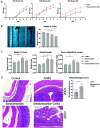Premorbid Steatohepatitis Increases the Seriousness of Dextran Sulfate Sodium-induced Ulcerative Colitis in Mice
- PMID: 36304494
- PMCID: PMC9547267
- DOI: 10.14218/JCTH.2021.00315
Premorbid Steatohepatitis Increases the Seriousness of Dextran Sulfate Sodium-induced Ulcerative Colitis in Mice
Abstract
Background and aims: The concurrence of nonalcoholic steatohepatitis (NASH) and ulcerative colitis (UC) is increasingly seen in clinical practice, but the underlying mechanisms remain unclear. This study aimed to develop a mouse model of the phenomenon by combining high-fat high-cholesterol diet (HFHCD)-induced NASH and dextran sulfate sodium (DSS)-induced UC, that would support mechanistic studies.
Methods: Male C57BL/6 mice were randomly assigned to two groups receiving either a chow diet or HFHCD for 12 weeks of NASH modeling. The mice were the divided into four subgroups for UC modeling: (1) A control group given a chow diet with normal drinking water; (2) A colitis group given chow diet with 2% DSS in drinking water; (3) A steatohepatitis group given HFHCD with normal drinking water; and (4) A steatohepatitis + colitis group given HFHCD with 2% DSS in drinking water.
Results: NASH plus UC had high mortality (58.3%). Neither NASH nor UC alone were fatal. Although DSS-induced colitis did not exacerbate histological liver injury in HFHCD-fed mice, premorbid NASH significantly increased UC-related gut injury compared with UC alone. It was characterized by a significantly shorter colon, more colonic congestion, and a higher histopathological score (p<0.05). Inflammatory (tumor necrosis factor-alpha, interleukin 1 beta, C-C motif chemokine ligand 2, and nuclear factor kappa B) and apoptotic (Bcl2, Bad, Bim, and Bax) signaling pathways were significantly altered in distal colon tissues collected from mice with steatohepatitis + colitis compared with the other experimental groups.
Conclusions: Premorbid steatohepatitis significantly aggravated DSS-induced colitis and brought about a lethal phenotype. Potential links between NASH and UC pathogeneses can be investigated using this model.
Keywords: Inflammatory bowel disease; Mortality.; Mouse model; Nonalcoholic fatty liver disease; Ulcerative colitis.
© 2022 Authors.
Conflict of interest statement
JGF has been an associate editor of Journal of Clinical and Translational Hepatology since 2022.The other authors have no conflicts of interest related to this publication.
Figures







Similar articles
-
Dextran Sulfate Sodium Salt-Induced Colitis Aggravates Gut Microbiota Dysbiosis and Liver Injury in Mice With Non-alcoholic Steatohepatitis.Front Microbiol. 2021 Nov 2;12:756299. doi: 10.3389/fmicb.2021.756299. eCollection 2021. Front Microbiol. 2021. PMID: 34795650 Free PMC article.
-
DSS colitis promotes tumorigenesis and fibrogenesis in a choline-deficient high-fat diet-induced NASH mouse model.Biochem Biophys Res Commun. 2016 Jan 29;470(1):15-21. doi: 10.1016/j.bbrc.2015.12.012. Epub 2015 Dec 10. Biochem Biophys Res Commun. 2016. PMID: 26682925
-
DSS induced colitis increases portal LPS levels and enhances hepatic inflammation and fibrogenesis in experimental NASH.J Hepatol. 2011 Dec;55(6):1391-9. doi: 10.1016/j.jhep.2011.02.035. Epub 2011 Apr 13. J Hepatol. 2011. PMID: 21703208
-
Jianpi Qingchang decoction alleviates ulcerative colitis by inhibiting nuclear factor-κB activation.World J Gastroenterol. 2017 Feb 21;23(7):1180-1188. doi: 10.3748/wjg.v23.i7.1180. World J Gastroenterol. 2017. PMID: 28275298 Free PMC article.
-
Anti-inflammatory effects of Brucea javanica oil emulsion by suppressing NF-κB activation on dextran sulfate sodium-induced ulcerative colitis in mice.J Ethnopharmacol. 2017 Feb 23;198:389-398. doi: 10.1016/j.jep.2017.01.042. Epub 2017 Jan 22. J Ethnopharmacol. 2017. PMID: 28119098
Cited by
-
Exploring the butyrate metabolism-related shared genes in metabolic associated steatohepatitis and ulcerative colitis.Sci Rep. 2024 Jul 10;14(1):15949. doi: 10.1038/s41598-024-66574-0. Sci Rep. 2024. PMID: 38987612 Free PMC article.
-
Transcriptomic Landscape Analysis Reveals a Persistent DNA Damage Response in Metabolic Dysfunction-associated Steatohepatitis Post-dietary Intervention.J Clin Transl Hepatol. 2024 Sep 28;12(9):765-779. doi: 10.14218/JCTH.2024.00111. Epub 2024 Aug 2. J Clin Transl Hepatol. 2024. PMID: 39280071 Free PMC article.
-
Utility of pemafibrate in nonalcoholic steatohepatitis model mice induced by a choline-deficient, high-fat diet and dextran sulfate sodium.Biochem Biophys Rep. 2024 May 3;38:101724. doi: 10.1016/j.bbrep.2024.101724. eCollection 2024 Jul. Biochem Biophys Rep. 2024. PMID: 38737727 Free PMC article.
-
Utility of ultrasonography in a mouse model of non-alcoholic steatohepatitis induced by a choline-deficient, high-fat diet and dextran sulfate sodium.Biochem Biophys Rep. 2023 Nov 8;36:101575. doi: 10.1016/j.bbrep.2023.101575. eCollection 2023 Dec. Biochem Biophys Rep. 2023. PMID: 38115886 Free PMC article.
-
Dietary Supplementation of Haskap Berry (Lonicera caerulea L.) Anthocyanins and Probiotics Attenuate Dextran Sulfate Sodium-Induced Colitis: Evidence from an Experimental Animal Model.Foods. 2024 Jun 24;13(13):1987. doi: 10.3390/foods13131987. Foods. 2024. PMID: 38998493 Free PMC article.
References
LinkOut - more resources
Full Text Sources
Research Materials
